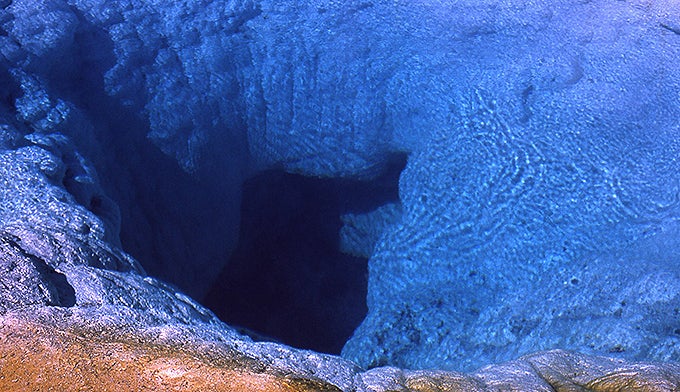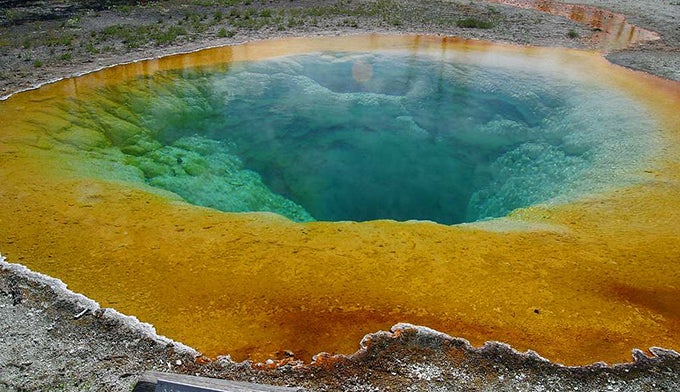
Across the globe, Yellowstone National Park is respected for its epic landscapes, untouched wildlife, and for possessing enough natural wonders to stuff a month-long itinerary.
Millions of people make their way to Yellowstone each year, and most don’t have an entire month to spend. Often part of a more extensive American road trip, this is one national park that can completely change your life in a single day.
Yellowstone is major bucket list material: bears and bison, geological terraces, geysers, and sweeping valleys, all with an overlay of solemnness that inspires self-reflection. Yes, you can experience all of that even if you’re short on time. Pull out your hiking pack list and get PUMPED-
Here’s how to spend 1 day in Yellowstone National Park, an itinerary:
Is it really possible to do Yellowstone National Park in one day?

The long answer is no, and the short answer is yes.
Yellowstone National Park is more than massive- It’s the largest national park in the United States outside Alaska.
With thousands of acres, 5 entrances, canyons, geyser basins, Old Faithful’s schedule, and so much fantastic wildlife, extending a Yellowstone Itinerary is easier than shrinking one.
However, like all National Parks, Yellowstone has a few highlights that can be comfortably explored in a day.
When to visit Yellowstone

Summer: Peak season is June- August. I highly suggest avoiding these months- just imagine how popular (crowded) Yellowstone is!
Spring and Fall: Yellowstone is loaded with both colorful fall foliage and inspiring spring wildflowers. So aim for late March and September to avoid the tourist rushes.
Winter: You can’t access most of the park’s interior (where Old Faithful and all the popular stuff lives) in the winter.
Where to fly into Yellowstone National Park

You know this national park is massive. Most people fly into Bozeman Yellowstone International in Montana, about an hour from the park’s north entrance.
There are many other airports, but they’re all tiny.
The most scenic and potentially cost-effective option is to fly into Salt Lake City, a 7-hour road trip away.
The Highlights
Enter From: West Entrance Station
With our 1 day itinerary, we focus on the best of the best; Yellowstone National Park’s most iconic sites and wildlife. Here’s a rundown of what these sites actually are (hint: different forms of hot springs):

5 types of Hydrothermal Features in Yellowstone:
- Hot springs: Pools of hydrothermally heated water. FYI, Hot Springs at Yellowstone are too hot and illegal to swim in.
- Geysers: Hot springs that erupt due to pressure build-up.
- Mudpots: Hot springs that are acidic enough to dissolve the surrounding rock.
- Travertine Terraces: Hot springs rise up through limestone and deposit calcite, leaving behind cascading tiers of minerals in balcony-like formations, such as Mammoth Hot Springs.
- Fumaroles: Also known as steam vents, Fumaroles constantly release hot steam.
Old Faithful
The first place to stop for any Yellowstone itinerary should always be Old Faithful.
Old Faithful was the first geyser in Yellowstone to be given a name. The Washburn-Langford-Doane Expedition really liked this geyser because it seemed to “faithfully” erupt every hour-ish.
I say ‘ish’ because, despite the popular belief, Old Faithful doesn’t erupt every hour but roughly every 91 minutes.
Download this app to get the approximate time of Old Faithful’s next eruption.

How to See Old Faithful
Look, I hate having extra apps on my phone, too, even temporarily.
But this app lets you see Old Faithful’s predicted eruptions. Make sure to screenshot because once you are near the geyser, you will have classic National Park reception- none at all. Alternatively, you can bring your own internet.
Visit Old Faithful before you do anything else because
- Crowds increase throughout the day
- This is a Yellowstone icon, so you don’t want to miss it
Grand Prismatic Spring
Once you’ve seen Old Faithful, drive 16 minutes to Grand Prismatic Spring-
As the third-largest spring in the entire world, Grand Prismatic Spring is a must-do at Yellowstone. The colorful orange, yellow, and green bands get their hues from different species of heat-sensitive bacteria living in the water.
Truly unlike anything I’ve seen before, Grand Prismatic Spring was my favorite stop and one that I’ll always remember as a place I felt appreciative to be alive and privileged to visit such bucket list locations.
How to get photos of Grand Prismatic Spring:
First, do the boardwalk so that you can take photos directly in front of the spring and appreciate how vivid the color really is up close:

Next, take the 0.6 mile, 15-20 minute walk up the Grand Prismatic Overlook Trail to get a bird’s eye view:

Mammoth Hot Springs
Yes, Mammoth Hot Springs is an hour’s drive from Grand Prismatic, but it’s well worth the effort and puts you close to Lamar Valley.
The most well-known example of a Travertine Terrace at Yellowstone, Mammoth Springs, looks like a cave that has been turned inside out.
Set further away from attractions like Old Faithful, the sparkling limestone and calcite deposits of Mammoth Springs reflect against shades of beiges and burnt orange for a calming, magical atmosphere.

Expect to spend about an hour walking the upper and lower terraces of Mammoth Hot Springs, with about 300 feet of elevation change.
Note: Mammoth Hot Springs teaches up to 170 degrees and 1200 feet deep, so its waters are not for swimming or touching.
Get Stuck at a Bison Crossing

You haven’t been to Yellowstone until you’ve been in a bison-induced traffic jam.
Even with a single day at the park, it’s inevitable that at some point, you’ll encounter a herd of bison, either out in the distance, grazing along the pavement, or just straight up walking across the road.
What to do:
Take photos and videos and soak up the sights from the safety of your car with a pair of binoculars. Check out this useful, in-depth guide for navigating your vehicle through the bison.
What not to do:
Attempt to feed, touch or approach the bison. They’re big, dangerous, wild animals, even as they are CUTE.
Sunset and Wildlife in Lamar Valley
End your day by driving the gorgeous 33 miles of Lamar Valley, America’s Serengeti, about an hour from Mammoth Hot Springs.
If you’ve ever watched a National Geographic special about wolves or bison in Yellowstone, it was likely filmed in either the Hayden or Lamar Valley. These are the most Yellowstone’y parts of Yellowstone.
Sunset in Lamar Valley was one of the best I’ve ever experienced- the fields were ablaze, the world was quiet, and the bison were meandering in the distance. If you have more than one day at Yellowstone, I highly recommend both valleys, but on this one-day itinerary, I vote for Lamar.
Lamar Vs. Hayden Valley
Yellowstone’s two big valleys have many of the same benefits, such as animal sightings, expansive views, and endless photo ops.
The Biggest Difference: Accessibility. While Lamar Valley is open all year, Hayden Valley is closed to vehicles from November to April.
Hayden Valley is on the main tourist loop in the summer months and sees much more traffic and tour buses than Lamar Valley, which is comparatively more private.
How to See Wildlife at Yellowstone
What to look for:
Yellowstone National Park is best known for its bison. Bears, wolves, elk, badgers, otters, and foxes also make homes here but aren’t as common to see.
When to look:
Animals are most active at dawn and dusk, conveniently when tourists are least active.

Best places to look:
Without a doubt, Lamar Valley is the best place to see bears, bison, and wolves in Yellowstone, and Hayden Valley is a close second.
Get daily animal updates:
Park Rangers at the entrance stations will give you the most accurate maps and updates of where animals have been spotted on the day of your visit, just ask.
A word on wolves:
Wolves are present at Yellowstone but are most visible from February to March. Stay on the lookout but don’t get your hopes up.
Watch for groups of people pulled off to the side of the road or gathering excitedly. They’re usually stopping for something you’d also want to see.
Critical Tips
The #1 Most Important Tip for Yellowstone:
If you do nothing else- Stay on the boardwalk– every slight shift in the environment can cause micro changes to the hot springs. Enough small changes can cause larger, permanent changes.
Check out these photos of the Morning Glory Geyser, courtesy of Yellowstone Park:


Venturing off the boardwalk is also federally illegal and can be deadly. Just don’t.
Book in Advance:
This may seem redundant, but over 4 million people visit Yellowstone each year, mostly within 3 months. Even if you’re not regularly the type to make reservations in advance, you’ll want to make an exception here.
WATER:
You don’t want to be hours away from hydration. Consider Hydration Packets for an extra boost of electrolytes. I like this refillable water bottle because it can be rolled down to fit into your pocket when empty.
Bring food, or you will starve:
There is nothing here besides your typical expensive, booked-out national park restaurant.
Binoculars:
Stay a safe distance from all animals. If you want to see one up close, peep them through your binoculars.
Pin it for later


Check-in
What did you do on your one day in Yellowstone, and how much did this itinerary help you?
Let me know in the comments below or on social media.




